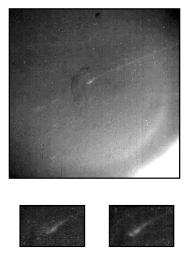This image, taken by NASA's Galileo spacecraft, shows the darkside of Jupiter, the part not illuminated by sunlight. The curved line crossing from the lower left to the upper right is the auroral arc on the horizon. With north at the top of the image, the central part of the auroral arc has a latitude of 57 degrees north. When this same region was imaged 30 seconds later, the central part had changed. The left and right boxes below show a magnified view of the central region at the earlier and later times, respectively. The aurora is dynamic on Jupiter, just as it is here on Earth. The eerie, glowing light is created when molecules in the upper atmosphere are struck by charge particles from the space around Jupiter. Fluctuations in the charged particle flow cause variations in the auroral emission.
This image was part of a multi-instrument set of observations made as Galileo flew through a region of space rich in charged particles. The particles follow the magnetic field and, in this case, the spacecraft was flying through the particular field line that was imaged. With these observations, scientists hope to learn more about the particles and their interaction with the molecules in the atmosphere. This image provides a severe test of the camera optics. The overexposed region at the lower right is the illuminated part of the planet, which is much brighter than the aurora. When light from this region is scattered into the telescope, it creates a diffuse background. The long exposure subjects the detector to more cosmic rays than usual. These create spikes, the bright dots that are sprinkled throughout the image. These images were taken in the clear filter of the solid state imaging (CCD) system aboard the Galileo spacecraft on Nov. 5, 1996. Each pixel subtends a square about 30 kilometers (18.5 miles) throughout the image. The range is 1.433 million kilometers (0.89 million miles).
Launched in October 1989, Galileo entered orbit around Jupiter on Dec. 7, 1995. The spacecraft's mission is to conduct detailed studies of the giant planet, its largest moons and its magnetic environment. The Jet Propulsion Laboratory, Pasadena, CA, manages the mission for NASA's Office of Space Science, Washington, DC.
This image and other images and data received from Galileo are on the Galileo mission home page on the World Wide Web at http://galileo.jpl.nasa.gov. Background information and educational context for the images can be found at http://www.jpl.nasa.gov/galileo/sepo.

 Planetary Data System
Planetary Data System












